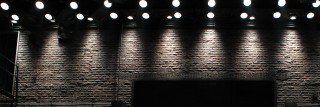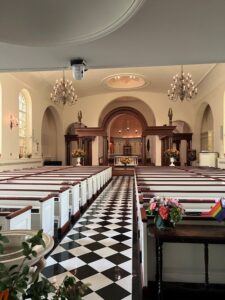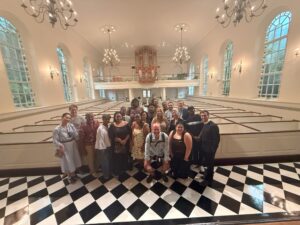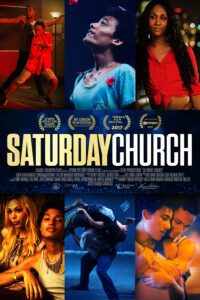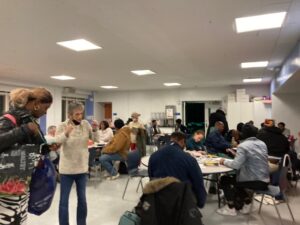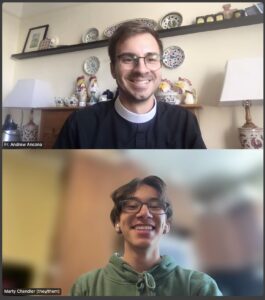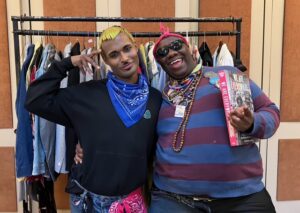
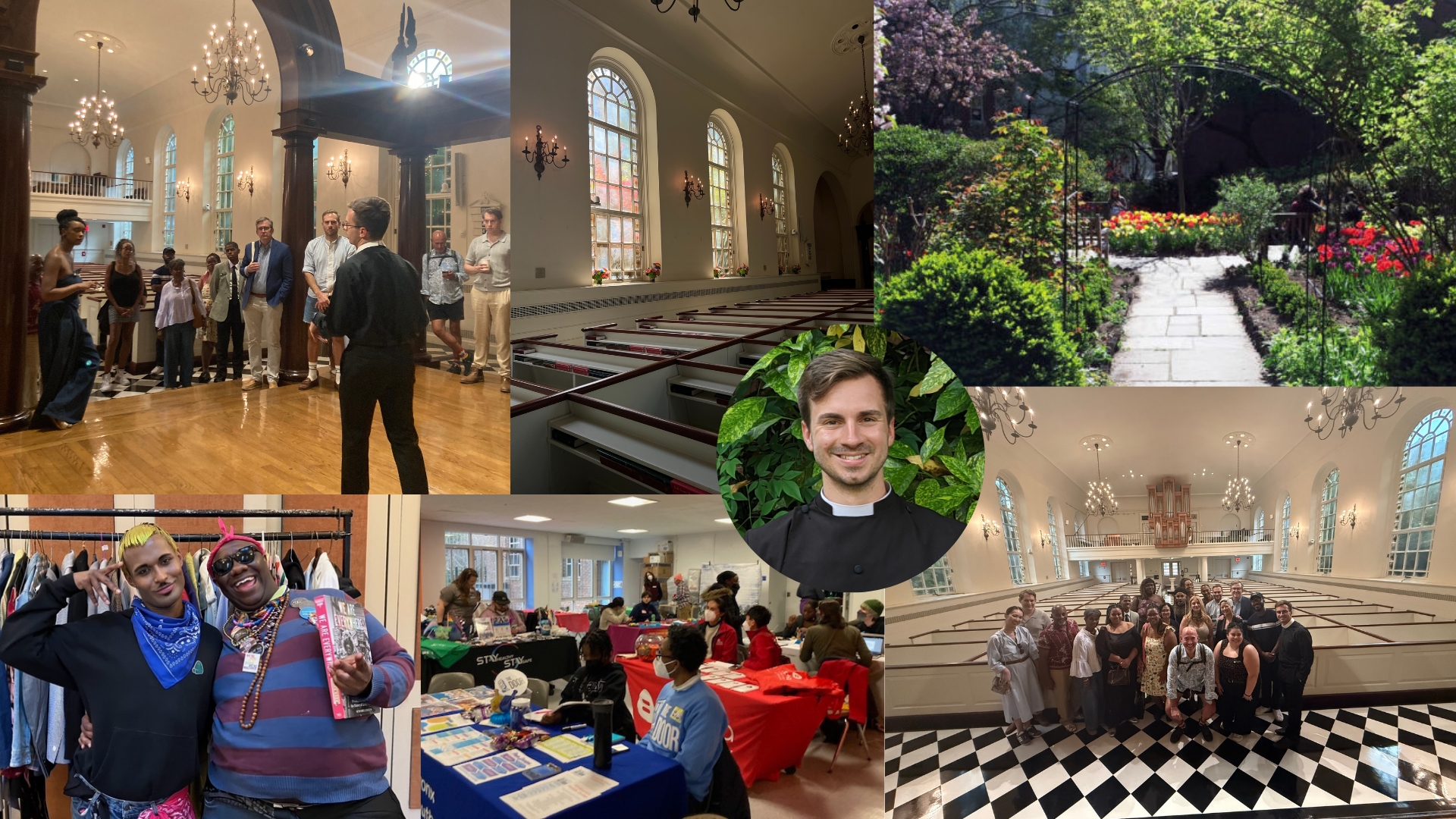
Before SATURDAY CHURCH hit the NYTW stage, and before Damon Cardasis wrote and directed his 2017 film, the West Village-based Church of St. Luke in the Fields opened its doors to members of the LGBTQ+ community and has continued to do so for generations.
Art & Acceptance, St. Luke’s Saturday evening drop-in program for LGBTQ+ young adults, inspired the story at the heart of the film and now musical, serving as a place for the protagonist Ulysses to find community, belonging, and self-expression. The program still runs every Saturday.
NYTW Education & Engagement Associate Marty Chandler sat down with Father Andrew Ancona to discuss the history and impactful work of St. Luke in the Fields, what a night at Art & Acceptance looks like, and what lessons of love we can draw from these stories to inspire us right now.
—
MARTY CHANDLER: Thank you so much for your time, Father Andrew! I would love if you could start by introducing yourself and your role with St. Luke’s.
FATHER ANDREW ANCONA: I’m Father Andrew Ancona, I’m the Senior Associate Priest at the Church of St. Luke in the Fields. I’ve been at St. Luke’s for almost five and a half years now, and my role has changed throughout, but I think one of the things that has always spoken to me about the ministry work that I’ve gotten to do at St. Luke’s is how community and spirituality and faith all overlap in a way that is all about welcome, hospitality, and finding out who we are as we connect to other people. My work at St. Luke’s is really about making sure that anyone who crosses over the doors, the threshold, knows that they have a place to belong, that they are welcome, and that we are just really glad to be a part of the community together.
MARTY: You and I have talked in the past before about the history of St. Luke’s, the HIV/AIDS epidemic, and various other work, but I’d love for you to speak a little bit more about that history.
FR. ANDREW: Our name, St. Luke in the Fields—it’s a little bit strange today. People often ask, like, why is it called that? When the church was founded in the 1820s, Greenwich Village, or now the West Village, was very much a distinct community outside of Manhattan, outside of New York City. Literally, we were surrounded by orchards, fields, and pastures. The community of Greenwich Village was a community on the margins, and I think that that’s something that we really need to pay attention to, as we tell this story about St. Luke’s.
The church was founded as a parish for the local community, particularly with the hope of serving the working-class neighborhoods that lived around the parish. This really is the root of our identity as a community of faith, in particular. We are called to the margins always.
Towards the end of the 19th century, the neighborhood, as New York City expanded, became struck by disease and sickness, and the church, once again, opened its doors as a place of care and nourishment, especially when the neighborhood was going through that time of illness. This is a recurring theme.
A man named John Leake left in his will an endowment for a weekly dole, which is basically a weekly allowance of bread, to be distributed at Trinity Church, which did so until 1860. After that, it moved to St. John’s Chapel on Canal Street for a short while, before finally becoming the first “Saturday Church” program at St Luke’s. It was still going at St Luke’s in 1919 as reported in the local paper. There was no expectation that these families would pay it back, that they would offer something in return. It was simply a gift of nourishment, and ultimately hospitality and care from the church to the neighborhood, which I think is also a recurring theme, in what we see in our story.
A lot of the wealthier families went north as the city expanded. And the West Village began to take on the characteristic that I think most people around today remember it as—a little seedier, a little, funkier—and as we get into the 20th century, in the mid-century in particular, that’s where this birth of the gay liberation movement comes from, in a community that once again is very much on the margins of the city of Manhattan.
Unprecedented tragedy strikes within the gay community, in the ‘80s. So, what was a growing community of love is shaken by the AIDS epidemic. And in our community in particular, this was felt quite strongly, because, and we know from the stories, it was out of control. I mean, people didn’t know how to respond, and I think we felt a little bit of this during the COVID-19 pandemic, too.


One thing that I admire about the people of St. Luke’s, and in the neighborhood in general, is that even when we weren’t sure about the course of the illness, the science, and all of that, the one thing that we do know how to do is keep the doors open. We know how to be a community of love and hospitality. And so, the church kept its doors open when so many other communities did not. They hosted dinners on Saturdays for folks who living with AIDS and their caregivers. Again, no expectation that anybody’s going to be able to return the favor, as it were. It’s just a place to belong, and to know that you are loved and cared for, and most of all, to know that you are seen in such a way that whatever you’re experiencing doesn’t define you. And I think that this is the whole thread of our presence and of our mission at the end of the day. It is a bedrock, foundation, a core value of our faith to honor and to cherish the human dignity that we all have. So, I think that that’s really important to say in this time in particular, when faith is actually being weaponized against human dignity.
Another part of this is the continual movement of the gay liberation movement, which now is even more expansive than it was when it first started. The programs at St. Luke’s in the early 2000s began to shift because the needs of the neighborhood, once again, were changing. The ministries at St. Luke’s began to really serve young queer people, transgender people, people of color, who were being marginalized from their own communities.
And this is where we find the story of Saturday Church.
And that’s really where we are today, still, actually. These programs have been running in some form of the Saturday evening, “Saturday Church” model, for about 20 years.
And one might like to think that things have changed, and they have in some ways, and in other ways, we still have a lot of work to do. My sincere hope, my prayer, is that we’re entering into a rejoicing season.
If I could summarize: the mission, the presence of St. Luke’s, and the people who make up our community have always been on the margins and across the margins. But those margins have never defined who we are or what we’re capable of.
MARTY: Wow, that was all so beautifully put. There were so many touchpoints that I see as throughlines across these time periods and our relationship, just within the two villages. I am thinking a lot about the history of New York Theatre Workshop producing RENT, for example. I also loved hearing the history of the weekly dole as a theme in and of itself. That’s exactly what Saturday Church is all about.
This leads so well into discussing the Art and Acceptance program. Could you share more about the program and what it looks like each week? What’s a normal night at the Saturday Church? What are some of the activities going on?
FR. ANDREW: I think that Saturday Church is a wonderful way to call the program because Saturday Church is gathering, it’s eating, and it’s friendship. I think that that is what happens each Saturday when folks come to us for the Art and Acceptance Program. We have anywhere from 40 to 50, sometimes more, guests join us each week. There’s always a meal served, so it’s an opportunity to sit with your neighbors, and also to be fed, because that’s an important part of our humanity.
Other activities that we enjoy each week: there’s nail-painting, art, dancing, music. I think the guests’ favorite is the karaoke night, when we bring out the karaoke machine and folks can sing and vibe and just have a really great time. I’ve never seen a quiet evening at Art and Acceptance.
I think it’s such a wonderful thing because a lot of the noise is just joyfulness. One of the things that surprised me when I first kind of came into the program was how much the guests know each other, and how much volunteers and guests know each other, too. And we see this in the film (Saturday Church), this kind of relationship between the entire community.
I’m really grateful for the partners that we have in this work. I know it’s a little bit of a cliché, but it takes a village, and I think again, it kind of weaves through the history of our narrative, you know, it’s not just people who are a part of the St. Luke’s community that are doing this work, but we have partners from around the city. I’m grateful for this new partnership with you all.
MARTY: One of the themes that I’ve been thinking about from the film and the musical is this important conversation about the various complicated relationships that people have to religious spaces, particularly as queer people. Even just hearing the way that you talk about the philosophy behind Art and Acceptance, and that ‘acceptance’ is even part of the title of the program, I feel like there’s something really moving about the impact this is making. Do you have thoughts on that specific theme?
FR. ANDREW: I do. One of the things that we talk a lot about in the queer community is chosen family, and this touches on some of the complications that people might feel from either within their own biological family or their own backgrounds, be it family, be it faith, etc. We talk at St. Luke’s all the time about how in the community, we are a chosen family. And what is the value that binds family together? It’s not blood, it’s not likeness, it’s love. I think when we talk about what we have to offer, it’s this simple gift of love and compassion, that joins us together. That’s a community of faith.
MARTY: Do you have a favorite memory that stands out from Art and Acceptance?
FR. ANDREW: Oh, there’s so many things. I love art, I maybe consider myself a little bit of an artist. I think one of my favorite moments of my own personal engagement in the program was teaching some art lessons to the guests. I love painting and I love watercolors. I brought supplies one week, with no expectations: we’re just gonna try to express ourselves in a joyful way, and it was fun to share something I find joy in, and watch other people find joy in it too.
I was sitting at the table and I brought out the paintbrushes, and one of the guests at the table said, “Oh, could I see one of those? That brush is perfect for my eyeshadow. I’ve been looking for something like this for my whole life.”
I thought, this is amazing. I had no expectation that that would be the kind of response to what I was offering. It was just a wonderful example of somebody bringing themselves to the table, no pressure to perform, no pressure to even conscript to the activity that was happening.
MARTY: That’s so fun, and again, it goes back to this theme of how you may come to Art and Acceptance expecting one thing and walk away with something else. Is there anything that you want to share with anyone who might want to get involved, or how they can support the program?
FR. ANDREW: We’re always looking for partners and volunteers. I think a lot of people don’t know where to start, and so I do want to say this: if you’re thinking about connecting to a community that’s in need, be it our community here at St. Luke’s or another community in the city, you don’t always have to know the right thing to say or do, but if you can just open yourself up to the possibility of loving another person to the best of your ability, I think that’s the perfect place to start. And of course, if you feel like St. Luke’s might be a place where you’d like to do that.
We would love to welcome anyone who’s curious about learning more. You can shadow, you can join us for an evening without necessarily having to step into one of the active leadership roles. There are other opportunities to volunteer on the block, too, behind the scenes in more of a support role. Those are important too. We always need our stagehands; I think you know how that works.
MARTY: Haha yes!
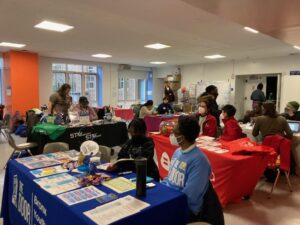
“It takes a village: it’s not just people who are a part of the St. Luke’s community that are doing this work,” said Father Andrew.
FR. ANDREW: Like, folding clothes for the guests to receive from the community closet, sorting clothes, making meals…whether it’s an individual project, or it’s a community partnership, we welcome these kinds of connections. And again, you know, you don’t have to check yourself at the door to come and be with us, so all are welcome to come and be a part of this amazing community. You can do that just by calling us at the parish office.
Hannah Sohn is our outreach manager, and she often receives requests and inquiries for partnerships. I’m also happy to speak to anyone who’s thinking about joining us. We would just be thrilled if folks wanted to get in touch, and even if it’s just to have a conversation.
MARTY: We really appreciate you, Hannah, and everyone at St. Luke’s! Father Andrew, this has been so wonderful, thank you. Are there any last reflections you’d like to share?
FR. ANDREW: I want to express my gratitude for the people of St. Luke’s throughout the ages, throughout the generations, who have dedicated themselves to serving and loving our neighbors. I want to say thank you to all our partners, everyone who’s crossed the door to lend a helping hand, and, most of all, I just want to uplift our guests and the people that we serve. It’s important to recognize that members of our community in need are very much a part of our community: we see you, and we love you, and we hope that you always feel like you belong in our community.
—
St. Luke in the Fields is located at 487 Hudson St. Interested in getting involved? Reach out to outreach@stlukeinthefields.org or call (212) 924-0562 to learn more about how you can volunteer or support.
Explore more
Categories: 2025/26 Season and For The Culture. Tags: For The Culture, Marty Chandler, and Saturday Church.
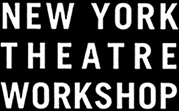
 My Cart
My Cart My Account
My Account Gift Certificates
Gift Certificates Find Us
Find Us